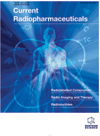-
s Biodistribution of Lipid Nanoparticles: A Comparative Study of Pulmonary versus Intravenous Administration in Rats
- Source: Current Radiopharmaceuticals, Volume 5, Issue 2, Apr 2012, p. 158 - 165
-
- 01 Apr 2012
Abstract
The advent of nanomedicine and increase knowledge on cellular and molecular biology has opened new opportunities on the clinical field. Selective drug targeting and protection of healthy tissues rules the rising interest that is being devoted to drug delivery system strategies, considering that the accurate choice of the carrier molecule will determine the pharmacokinetics and pharmacodynamics of drugs, yielding higher therapeutic efficacy. Despite the improvements in surgery and immunological approaches, tumor staging and cancer therapy remains a challenge, typically because they are ineffective in advanced stages of the disease, but also due to the conventional administration route (intravenous), and consequently the non-specificity of the potentially toxic drugs. The issue currently under the spotlight in drug targeting is the concept of drug delivery systems (DDS) and the impact that is inherent to their selectivity. Moreover, these particulate systems bring forth the possibility of using alternative routes to the conventional intravenous administration. This article reviews the applications of gamma-scintigraphic image technique to evaluate the advances and research on DDS engineering to the pulmonary administration, and the dependency of lung particle removal mechanism on both the administration route and the particulate system characteristic, based on literature data, as well as through the experimental studies performed in our group.


